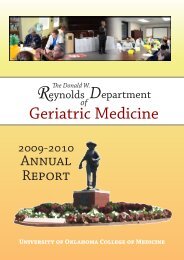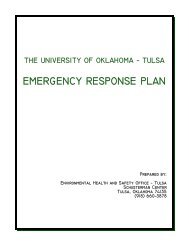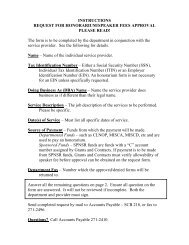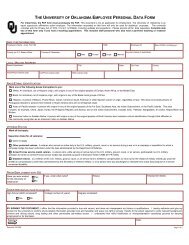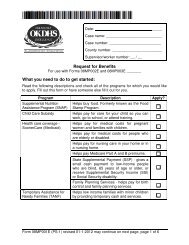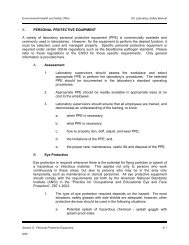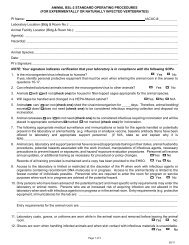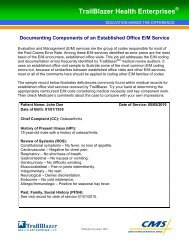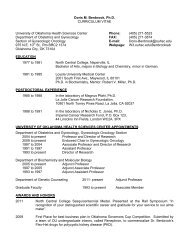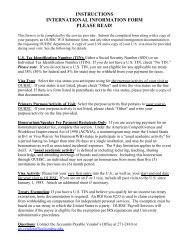The Unofficial Guide to First Year - University of Oklahoma Health ...
The Unofficial Guide to First Year - University of Oklahoma Health ...
The Unofficial Guide to First Year - University of Oklahoma Health ...
Create successful ePaper yourself
Turn your PDF publications into a flip-book with our unique Google optimized e-Paper software.
UNOFFICIAL GUIDE<br />
NEURO LAB:<br />
<strong>The</strong> original author’s advice: “GO TO LAB! While the lab session as a whole is<br />
informal, I feel it is very helpful <strong>to</strong> be able <strong>to</strong> match an actual structure with the<br />
function described in lecture…not <strong>to</strong> mention, it might be nice <strong>to</strong> see the actual<br />
specimens that will be used on the practical. Many may find the best resource<br />
for Neuro lab is the Hippocrates INTERACTIVE LAB GUIDE, as it shows any<br />
and every structure that could possibly show up on the exam (see below). I<br />
would suggest looking over the guide before going down <strong>to</strong> lab and then asking<br />
Dr. Blair or O’Don <strong>to</strong> show you anything you are confused on or cannot find,<br />
especially deeper structures. It would also be helpful <strong>to</strong> ask if there are any other<br />
dissections that might be presented during the practical, as this gave our class<br />
fits!” My advice: don’t go <strong>to</strong> lab unless the practical exams in gross ana<strong>to</strong>my<br />
kicked your butt (keep in mind, I am home-schooler). Dr. Blair began doing a<br />
gross lab review for our class, in which he pointed out nearly (if not all) the gross<br />
structures we would be expected <strong>to</strong> know for the downstairs portion <strong>of</strong> the exam.<br />
I recommend watching Dr. Blair’s review once on normal speed and then twice<br />
more at double speed, naming all the structures before he does. If you are<br />
confused about the orientation <strong>of</strong> a structure, check on the lab guide. <strong>The</strong> best<br />
way <strong>to</strong> perform well on practical exams is <strong>to</strong> associate each structure with its<br />
surroundings. For the upstairs portion <strong>of</strong> the exam (the slides), I recommend<br />
putting in maybe two hours the night before memorizing the slides on the<br />
interactive lab guide and using part <strong>of</strong> your break in between the written exam<br />
and the practical <strong>to</strong> review these images. Memorize the circles, the colors, and<br />
the shape <strong>of</strong> the outline. Dr. Blair will use the same slides as those in the lab<br />
guide.<br />
TBLS AND IMPS:<br />
Our class was somewhat <strong>of</strong> a guinea pig class. Our year was the first <strong>to</strong><br />
incorporate Team Based Learning (TBLs) in<strong>to</strong> the curriculum. We had two<br />
hours <strong>of</strong> Neuro (and two hours <strong>of</strong> physiology) TBL every week. TBL may be very<br />
helpful when preparing for exams as it allows you <strong>to</strong> see what is emphasized,<br />
along with providing example questions <strong>to</strong> demonstrate the type <strong>of</strong> questions<br />
you will get on the exam. It is designed <strong>to</strong> keep you caught up on your studies<br />
and <strong>to</strong> initiate critical thinking about neuro and phys. <strong>The</strong> material comes from<br />
anything discussed prior <strong>to</strong> the TBL with a focus on new material from the past<br />
week. We were allowed <strong>to</strong> use our notes, the syllabus, and the web <strong>to</strong> answer the<br />
questions, so while being caught up is incredibly helpful, it isn’t essential. <strong>The</strong>re<br />
were two general formats for TBL: 1) you are presented with a clinical case from<br />
which you try <strong>to</strong> answer various related questions; and 2) stand alone questions<br />
that are not related <strong>to</strong> a larger case. <strong>The</strong> TBL consisted <strong>of</strong> usually nine <strong>to</strong> eleven<br />
questions which we discussed in assigned small groups composed <strong>of</strong> several<br />
people from you mod. We submitted our answers using an electronic<br />
79




